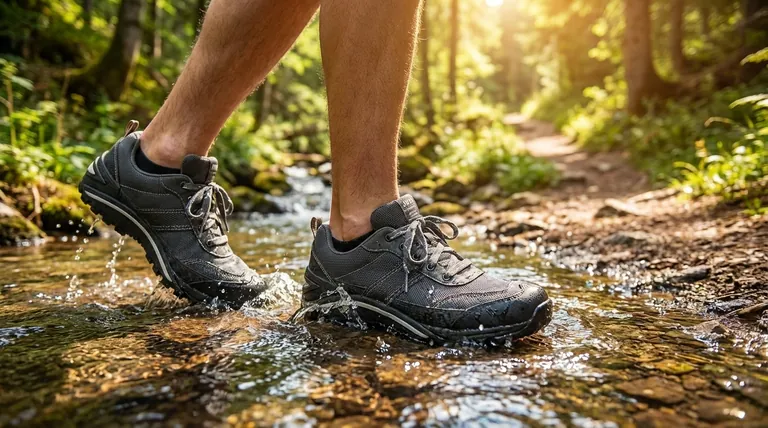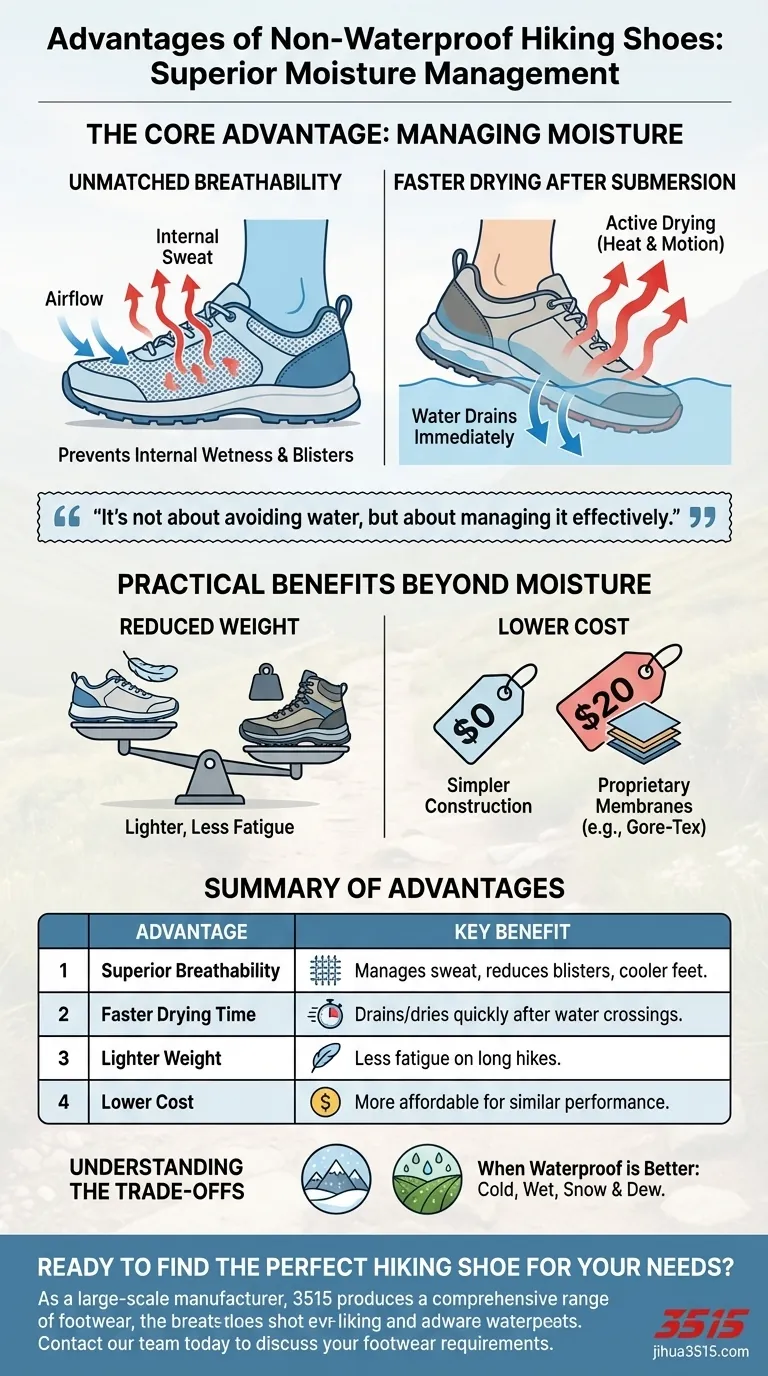The primary advantages of non-waterproof hiking shoes are superior breathability and significantly faster drying times. This combination excels at managing foot sweat, which reduces the risk of blisters, and allows the shoe to recover quickly after being submerged in water. They are also typically lighter and less expensive than their waterproof equivalents.
The decision between waterproof and non-waterproof hiking shoes is not about avoiding water, but about managing it effectively. Non-waterproof shoes prioritize breathability, managing moisture from the inside (sweat) and recovering rapidly from moisture from the outside (water crossings), making them the superior choice for many warm or very wet conditions.

The Core Advantage: Superior Moisture Management
The central benefit of non-waterproof footwear revolves around a simple principle: water needs a way to get out. This applies to moisture generated inside your shoe just as much as water that gets in from the outside.
Unmatched Breathability Prevents Internal Wetness
Your feet produce a significant amount of sweat, especially during strenuous activity. A non-waterproof shoe, typically made with mesh or porous materials, allows this sweat vapor to escape freely.
This constant airflow keeps your feet drier and cooler. By preventing the buildup of internal moisture, you drastically reduce the friction that leads to painful blisters and other skin issues.
Faster Drying Time After Submersion
It is a common misconception that waterproof shoes are always better for wet conditions. If you are doing a deep stream crossing, water will inevitably flow over the top of any shoe.
A waterproof shoe, once filled with water, becomes a bucket. The waterproof membrane that works so well to keep water out also works to keep it in, and it will take an extremely long time to dry.
In contrast, a non-waterproof shoe will drain almost immediately. The heat from your foot and the motion of walking will then actively pump air through the material, drying the shoe far more quickly.
Practical Benefits Beyond Moisture
Beyond their ability to handle water, non-waterproof shoes offer several other clear advantages that impact your comfort and budget.
Reduced Weight for Less Fatigue
Waterproof membranes and the associated layered construction add weight. While it may only be a few ounces per shoe, that weight is lifted thousands of times over a long day of hiking.
Choosing a lighter, non-waterproof shoe reduces fatigue, allowing you to move more efficiently and comfortably on the trail.
Lower Cost and Simpler Construction
The technology behind "waterproof-breathable" membranes like Gore-Tex is proprietary and expensive.
This cost is passed directly to the consumer. The non-waterproof version of the same shoe model is almost always more affordable, offering similar performance in the right conditions for less money.
Understanding the Trade-offs
Objectivity is critical when selecting gear. Non-waterproof shoes are not a universal solution, and their effectiveness is defined by the environment.
When Waterproof Shoes Are the Better Choice
Waterproof shoes excel in specific scenarios where keeping external moisture out is the absolute priority.
This includes hiking in cold, slushy, or snowy conditions where wet feet can be dangerous. They are also ideal for walking through dewy fields or in light, intermittent rain where submersion is not a risk.
The Limits of "Waterproof Breathable"
While modern waterproof membranes are marketed as "breathable," this term is relative. They allow some water vapor to pass through, but they are significantly less breathable than the open mesh of a non-waterproof shoe.
In warm or hot weather, you will almost always generate sweat faster than a waterproof membrane can vent it, leading to damp feet.
Making the Right Choice for Your Hike
Select your footwear based on the most likely conditions of your trip, not a hypothetical worst-case scenario.
- If your primary focus is hiking in hot or dry climates: Choose non-waterproof shoes for maximum breathability and comfort.
- If your primary focus is trips with frequent river or stream crossings: Non-waterproof shoes are far superior, as they will drain and dry between crossings.
- If your primary focus is hiking in consistently cold, wet, or snowy conditions: A waterproof shoe is essential for keeping your feet dry and warm.
- If your primary focus is all-purpose day hiking in moderate weather: A non-waterproof shoe often provides more comfort, especially if your feet tend to sweat.
Ultimately, choosing the right shoe is about understanding your environment and selecting the best tool for managing moisture, not just blocking it.
Summary Table:
| Advantage | Key Benefit |
|---|---|
| Superior Breathability | Manages sweat effectively, reducing blister risk and keeping feet cooler. |
| Faster Drying Time | Drains and dries quickly after submersion, unlike waterproof shoes. |
| Lighter Weight | Less fatigue on long hikes due to simpler construction. |
| Lower Cost | More affordable than waterproof versions of the same model. |
Ready to find the perfect hiking shoe for your needs?
As a large-scale manufacturer, 3515 produces a comprehensive range of footwear for distributors, brand owners, and bulk clients. Our production capabilities encompass all types of shoes and boots, including high-performance hiking footwear designed for optimal comfort and durability.
Let us help you equip your customers with the right gear. Contact our team today to discuss your footwear requirements and discover how we can support your business.
Visual Guide

Related Products
- Durable Rubber Sole Outdoor Shoes Wholesale & Custom Manufacturing
- Durable Rubber-Soled Utility Shoes for Wholesale & Custom Brand Manufacturing
- Wholesale Durable & Breathable Training Shoes for Custom Brands
- Premium Suede Sport Safety Shoes for Wholesale & Bulk Orders
- Safety Footwear Wholesale Manufacturer for Custom OEM/ODM Production
People Also Ask
- How do hiking shoes or boots protect feet from environmental hazards? A Guide to Trail-Ready Footwear
- What are the characteristics of heavy-duty hiking boots? Ultimate Guide for Rugged Terrain
- Why are rubber-soled shoes considered multi-weather footwear? Unlock All-Season Traction & Protection
- What are the disadvantages of vulcanized soles? Lack of Support & Durability Explained
- What were traditional shoe soles made from before rubber? The History of Leather Soles



















